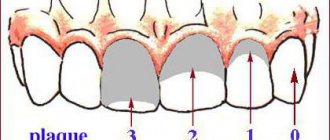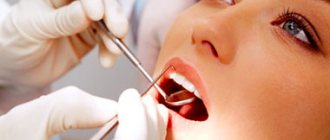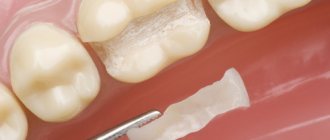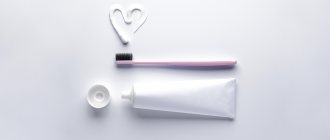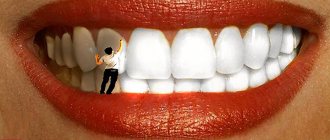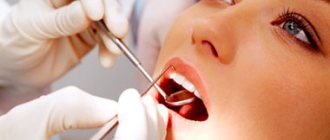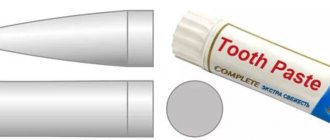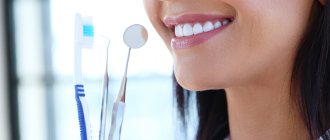A healthy oral cavity is a factor that has a positive impact on a person’s overall well-being and psychological state. Performing hygiene procedures is an accessible method of preventing various diseases, thanks to which you can prevent negative consequences for teeth and gums, as well as maintain the aesthetic appeal of your smile. As part of a clinical examination, dental indices are used to assess the condition of the oral cavity, which indicate the degree of development of identified pathologies.
CPU
KPU is an indicator of the degree of dental caries damage. K – teeth with caries, P – teeth with fillings, U – already missing teeth or those that will soon be removed. Putting all this data together, we can draw conclusions about the spread of caries in the patient’s oral cavity.
KPU index
The following KPUs can be identified.
- KPU of teeth (KPUz) - shows the number of teeth damaged by caries. It also talks about the number of fillings.
- KPU surfaces (KPUpov) - shows how much of the tooth surface is affected.
- KPUpol - provides information on the number of caries cavities and fillings.
There are several KPU indices that indicate the number of fillings and teeth affected by caries
Impermanent teeth are characterized as follows:
- kp – the number of temporary teeth with fillings or caries;
- kp – indicator of the number of damaged surfaces;
- checkpoint - shows how many caries cavities and dental fillings there are in the mouth.
Important! It is worth considering that teeth removed artificially or lost due to natural causes are not counted.
Children's teeth are characterized by the indices KP and KPU. To understand how far the disease has progressed, these indicators are added up. If the KPU is in the range of 6-10, it means that caries has gone quite far, from 3 to 5 - average damage, 1-2 - weak.
CPU in children
It is important to remember that you will not be able to get a reliable picture, since these indices have some disadvantages:
- extracted teeth are considered on par with cured ones;
- the index is not designed for the early stages of the disease.
The most well-known problems of KPUz and KPUpov are insufficient reliability during the increasing development of dental lesions due to the appearance of voids in already cured teeth, secondary caries, destruction of fillings and other things.
CPU in children and adults
Important! The degree of caries damage is characterized by percentages. To get the required figure, the number of respondents with manifestations of dental caries must be divided by the number of all survey participants, multiplied by one hundred.
To quantify caries lesions in a specific region, experts examine the level of intensity of dental caries damage:
- low – from 0 to 30%;
- average – from 31 to 80%;
- high – from 81 to 100%.
KPU index for Russia
When calculating these indices, early carious lesions (in the form of white spots) are not counted.
- Dental hygiene tools
Early carious lesions are not taken into account
To understand what the average number of indicators is for a particular group, you need to calculate the total number of personal indices and then divide by the number of study participants.
Caries in a specific population
Comparison of carious lesions in people in different regions and countries assumes the use of an arithmetic mean of the CPE.
The CPITN index is used to examine and monitor periodontal health. At the same time, changes that cannot be corrected (for example, tooth instability) are not recorded. CPITN does not provide information about the course of the disease and should not be used in treatment planning.
CPITN Index
Important! Use a probe with a ball at the end and a black strip at a 3.5 mm distance from the tip.
People over twenty years of age need to analyze several teeth from below and above (17/16, 11, 26/27, 37/36, 31, 46/47). If examination of the presented teeth is not possible, this is done on the remaining intact teeth.
Patients under nineteen years of age need to analyze teeth 16, 11, 26, 36, 31, 46.
CPITN Index
One of the important advantages of this index is that it is easy and fast, and produces a large amount of data that can be subjected to thorough analysis. The need for therapeutic measures is determined by the following criteria.
- CODE 0 (X) indicates that no therapeutic measures are required.
- CODE 1 indicates that the patient’s oral hygiene is not sufficiently observed.
- CODE 2 indicates that the person needs to undergo professional oral hygiene measures.
- CODE 3 says that you need to clean your mouth, do curettage to slow down inflammation and fix the pocket depth at 3 mm or more.
- CODE 4 – the condition can be corrected by deep curettage and careful adherence to oral hygiene. This code also indicates the need for a set of therapeutic measures.
Curettage
CPU in dentistry
Dentists should use these calculations during the initial examination of the patient. So, for example, the average values of the indices KPU, kp. KPU+KP of teeth and cavities in dentistry allows you to determine the intensity of carious lesions. These abbreviations contain the following meanings:
- K – carious permanent teeth;
- P – permanent teeth in which a filling is installed;
- U – extracted molars;
- j – temporary teeth affected by caries;
- p – filled temporary teeth.
- According to the World Health Organization, the average CP index for children 12 years old should be from 2.7 to 4.4, and for citizens aged 35-44 years 6.3-12.7.
RMA
PMA is the papillary-marginal-alveolar index. It allows you to reliably assess the clinical picture of gingivitis. There are many different versions of these indexes, but Parma is the most commonly used. The total number of teeth is calculated based on age: from 6 to 11 years – 24 teeth, from 12 to 14 years – 28 teeth, from 15 years – 30 teeth. When there are no lesions, the PMA index is zero.
RMA Index
Classification and types of CPU
The amount of damage to teeth by the carious process is expressed by the KPU index. This abbreviation stands for:
- K – total number of teeth with caries;
- P – number of sealed elements;
- Y is the number of units removed.
The sum of these three indicators determines the dynamics and speed of the carious phenomenon.
There are 3 types of CPU:
- teeth (otherwise KPUz) – the number of filled and carious units in a person;
- all surfaces (or KPUps) – the number of dental surfaces infected with caries;
- cavities (i.e. KPUpol) – the number of carious and filled cavities.
For milk units, other decodings are used:
- KPz – the number of treated and carious elements;
- Kppov – number of affected dental surfaces;
- Kppol – number of fillings and cavities.
In children, elements in the primary occlusion that are removed or lost during physiological changes are not taken into account.
They use 2 types of indices simultaneously: KPU and KP. To determine the intensity of the pathology, both of these indicators are summed up.
If the CPU is within the limit:
- from 6 to 10 – the speed and intensity of caries is high;
- 3-5 – moderate;
- up to 2 – low.
These indicators do not reveal an objective picture of the state of oral health, since they have the following negative aspects:
- Simultaneously treated and removed units are taken into account.
- Show the past picture of the disease and increase with a person’s age.
- The initial stage of the pathological process is not taken into account.
A serious drawback is also considered to be the unreliability of the indices when problem elements increase due to the appearance of new cavities in the treated units, the loss of old fillings, and the development of secondary caries.
The prevalence of the pathological process is expressed as a percentage. A certain number of individuals with different manifestations of the disease (with the exception of focal demineralization) is taken, divided by the total number examined in this group, and multiplied by 100.
When comparing the prevalence of the disease by region, a scheme is used based on the assessment criteria of the multiplicity of cases among 11-13 year old children:
| Index | Level |
| no more than 30% | isolated |
| up to 80% | average |
| over 80% | high |
To find out the dynamics and speed of caries, dentists rely on the following indices:
- KPU (P) – surfaces sealed and affected by pathology;
- KPU (Z) – elements sealed and affected by disease.
To track this process in adult patients, slightly different criteria are used:
- KPU (P) – treated and carious surfaces;
- KPU (Z) – cured, carious and removed elements.
Important! When calculating the result, carious lesions that look like pigment spots are not taken into account.
To calculate the average for a group, it is necessary to determine the total value of individual indicators and divide them by the number of people surveyed.
How effective is teeth whitening varnish, judging by reviews from experts and users.
Read here about how to quickly whiten your teeth at home.
At this address https://www.vash-dentist.ru/krasota-i-uxod/otbelivanie/maslo-chaynogo-dereva-dlya-domashnego-zubov.html you will find out whether there is any harm from the method of teeth whitening with tea tree oil.
Fedorov-Volodkina hygienic index
To assess a person’s independent oral hygiene, they use this index. It is best suited for children under six years of age. To calculate the index, the surface of six teeth from the lips is examined. A special composition paints the enamel, allowing plaque to be found. The probe allows you to detect stone formations of various types. To calculate the index, you need to add up all the resulting numbers and divide by the number of surfaces examined. Then they are folded.
Fedorov-Volodkina hygienic index
Oral hygiene indices.
Method for determining the Fedorov-Volodkina hygienic index // E.M. Melnichenko “Prevention of dental diseases”, Minsk, “Higher School”., 1990, pp. 3-17.
It is determined by the intensity of the color of the vestibular surface of the six lower frontal teeth by applying an iodine-iodide-potassium solution (Schiller-Pisarev liquid).
The calculation is carried out according to the formula:
Ksr (hygiene index) = Kn (total hygiene index for each of the six teeth) / n (number of teeth).
Coloring the entire surface of the crown is scored 5 points, 3/4 of the surface - 4, 1/2 of the surface - 3, 1/4 of the surface - 2 points. If there is no staining, 1 point is given. The indicator is assessed as follows: good index, satisfactory, unsatisfactory, bad, very bad.
However, the proposed method has a number of disadvantages:
— determination of the quality and quantity of dental plaque, assessment of the hygiene index was carried out only on one’s own teeth; — the use of known dyes is impossible when determining the amount of dental plaque on bridges, since these solutions are difficult to wash off from the surface of the dentures.
| Name | Facilities diagnostics | Self-control criteria |
| 1. Fedorov-Volodkina index | Lugol's solution 1.1-1.5 is good 1.6-2.0 - satisfactory 2.1-2.5 - unsatisfactory 2.6-3.4 - bad 3.5-5.0 - very bad | The vestibular surface of the six front teeth of the lower jaw - incisors and canines - is stained with Lugol's solution. Rating on a 5-point system: 5 points – the entire surface of the teeth is stained, 4 points – 3/4 of the tooth surface, 3 points - 1/2 of the tooth surface, 2 points - 1/4 of the tooth surface, 1 point - no staining Then find the arithmetic mean by dividing the sum of the color of all teeth by their number: K av = Kp: p. Good level of hygiene: Ksr=1.0-1.3 b IG = sum of points of six teeth 6. |
| 2. Green-Vermilion Index (1964) - universal hygiene index of the UIG | Schiller-Pisarev solution or Lugol's solution 0-0.6 good 0.7-1.6 satisfactory 1.7-2.5 unsatisfactory 2.6-3 - bad | Determine the presence of plaque and tartar on the buccal surface of the first upper molars, the lingual surface of the lower molars, and the vestibular surface 1| and lower |1 6 1| 6 6 | 1 6. On all surfaces, plaque is first determined, then tartar. 0 - no plaque (stone) 1 - plaque covers up to 1/3 of the tooth surface 2 - plaque covers from 1/3 to 2/3 of the tooth surface 3 – plaque covers more than 2/3 of the tooth surface Tartar assessment: 0 – absence of tartar 1 – supragingival tartar covers no more than 1/3 of the tooth crown 2 – supragingival tartar covers from 1/3 to 2/3 of the tooth crown, or single formations of subgingival tartar are detected 3 – supragingival tartar covers more than 2/3 of the tooth crown, or significant deposits of subgingival tartar are detected along the entire circumference of the tooth. SPI = sum of indicators of 6 teeth 6 The assessment of the tartar index is carried out similarly to UIG = IZN + IZK |
| 3. Index ONI-S | Schiller-Pisarev solution 0-no staining 1- staining up to 1/3 of the crown, 2- staining up to 2/3 of the crown 3- more than 2/3 of the tooth crown | Staining of the vestibular and lingual surfaces 6 1 | 6 6 | 1 6 The plaque index and stone index are summed up and the average is obtained. |
| RHP Index – Oral Hygiene Performance Index (Podshadley, Haley – 1968) | Color 6 teeth: 16, 26, 11, 31 – vestibular surfaces. 36, 46 – lingual surfaces | The examined surface is divided into 5 sections: 1-medial, 2-distal, 3-mid-occlusal, 4-central, 5-mid-cervical. Plaque is assessed at each site: 0 – no staining 1 – staining detected For each tooth, the site codes are summed up. Then the values of all examined teeth are summed up and the resulting sum is divided by the number of teeth. Index values: 0 - excellent 0.1-0.6 – good 0.7-1.6 – satisfactory 1.7 or more - unsatisfactory |
RNR
Six teeth are coated with a dye that allows plaque to be found. To indicate the total number, you need to determine the number for each surface by summing the code values of individual areas. Then these values are added up and divided by how many teeth a person has in total.
- Oral candidiasis
RHP index
The bite is assessed by the dental aesthetic index. It characterizes the health of the bite, dental location in the sagittal, vertical and transversal directions.
Important! Assessment begins at age twelve.
An external examination using a button probe is used.
Button probe
An aesthetic assessment characterizes each component of the index and allows them to be arranged according to various pathologies of the rows of teeth and occlusion.
The score is expressed as a percentage. The number of people who were diagnosed with caries is divided by the total number of participants in the control group, and then the resulting number is multiplied by 100.
KPU index assessment
To determine the degree of infection, dentists use three basic indicators.
In the case of assessing the prevalence of caries, a percentage value is used. The calculation method involves dividing the number of patients in whom pathology was detected by the total number of those who underwent examination, after which the result is multiplied by one hundred. When comparing regional indicators, data obtained during examinations of adolescents aged twelve years are used - a value not exceeding 30% is considered low.
The intensity of infection is calculated based on the number of elements affected by caries, and provides for the presence of five degrees. In the case of younger patients, the coefficient varies from 1.1 to 6.5, while for adults the range of values is 1.5-16.3.
To assess growth, periodic surveys are prescribed, during which the difference between the current and previous indicators is determined. The diagnostic results not only reflect the level of oral health, but also allow you to create a treatment plan that takes into account the specifics of each patient’s body.
Characteristic disadvantages
Among the disadvantages characteristic of the method under consideration are:
- Inclusion of both cured and extracted elements in the indicators;
- The influence on the overall picture of previous dynamics, characterized by an increase in intensity as they grow older;
- Ignoring the early stages of development of carious diseases.
Such shortcomings, in fact, limit the possibility of forming a detailed picture characterizing the state of oral health. Over time, new areas of caries localization, deformation and loss of fillings, as well as other processes are observed in the dentition. The specified data is summed up again during the next inspection, which leads to a distortion of the final results and general statistics.
Green-Vermillion index
The use of coloring agents is not required. The surfaces of teeth 16, 26, 11, 31, 36 and 46 are analyzed.
When there is no dental plaque, you can give zero points, if a third of the tooth surface is affected - one, up to two thirds - two, the rest - three points. Stone deposits are assessed similarly.
Green-Vermillion index
Silnes-Lowe Index
Using such an index, it is possible to estimate the thickness of plaque deposits near the gums in four areas of tooth enamel: vestibular, lingual, distal, mesial. The surface is dried, and then the tip of the probe is used to move along it near the gingival sulcus. A clean probe allows you to talk about zero points. When the coating is invisible, but sticks to the device, they set it to one. If the plaque is thin or medium, you can give it a 2. When the plaque clearly affects the areas near the gums and between the teeth, you can give it a three.
Silnes-Lowe Index
Important! The general index is the indices of specific teeth obtained as a result of the study, divided by their number in the mouth.
Conclusion
Hygienic indices are individual indicators for a person. They can assess the condition of the mouth and its health. Based on the characteristics of the human body, the specialist applies one of the techniques.
All of them are easy to carry out, do not cause discomfort or pain to the examined patient, and do not require preparatory manipulations. The solutions used for staining deposits are safe.
Thanks to such an assessment, the dentist can not only find out the initial condition of the oral cavity, but also make a forecast regarding the development of the condition in the future, and monitor changes in the gum tissue and teeth after treatment.
If you find an error, please select a piece of text and press Ctrl+Enter.
Tags hygiene index care
Did you like the article? stay tuned
Previous article
Does the price of the Zoom 4 teeth whitening method correspond to its quality and effectiveness?
Next article
Desensitizers in dentistry - effective elimination of dental hypersensitivity
Tartar Index
The Tartar Index identifies calculus deposits above and below the gums of the incisors or mandibular canines.
Tartar Index
Each surface is given points ranging from zero to three:
- Mouth rinse for gum inflammation
- 0 – absence of stone deposits;
- 1 – deposits up to 0.5 mm;
- 2 – deposits up to 1 mm;
- 3 – stone with a thickness of 1 mm and above.
CPITN (periodontal disease treatment need index)
This method covers 10 teeth, allowing the dentist to see the condition of the gums of the upper and lower jaws. Grades are given as follows:
- 0 – no disease symptoms;
- 1 – gums are bleeding;
- 2 – tartar was found above and below the gum;
- 3 – gum pocket 4-5 mm deep;
- 4 – gum pocket more than 6 mm.
It may come as a surprise to many that the condition of teeth can be determined using a formula, but this is the truth. Therefore, do not neglect maintaining oral hygiene, so as not to be a poor student in this calculation.
The iOrtho clinic network provides high-quality services for correcting malocclusion with Invisalign aligners, sign up for a consultation now!
Ramfjord index
The Ramfjord index is part of the periodontal index. It is designed to detect plaque on the vestibular, lingual and palatal surfaces, proximal surfaces of 11, 14, 26, 31, 34, 46 teeth. The enamel is painted with Bismarck brown solution and points are given.
Ramfjord index
The required number is obtained by dividing all points by how many teeth were examined.
Navi Index
The surface of the teeth is assessed from the side of the teeth. Before assessment, you need to rinse your mouth with 0.75% fuchsin.
Magenta
They think like this:
- 0 is set if there are no pathological deposits;
- 1 is placed when plaque deposits are painted only at the gum border;
- 2 is given if the plaque is noticeable at the gum line;
- 3 is set when a third of the tooth is occupied by deposits;
- 4 is given if two-thirds of the tooth is affected;
- 5 is given when more than two-thirds are affected.
Navi Index
Important! The resulting numerical value should be considered a conversion to the average number of one tooth of a particular person.
Turesky Index
Calculate using the Quigley-Hein system on the surfaces of the teeth from the lips and tongue:
- 0 – no problems found;
- 1 – small spots, the cervical part of the tooth is affected;
- 2 – line of damage up to a millimeter, not thick, without interruptions;
- 3 – a strip of a millimeter, but affects less than a third of the tooth surface;
- 4 – the lesion occupies up to two-thirds of the surface;
- 5 – more than two thirds of the tooth surface is affected.
Turesky Index
Arnim index
Allows you to evaluate the effectiveness of hygienic procedures carried out in the oral cavity, to identify plaque lesions on the surfaces of the incisors from the lips. They are dyed with erythrosine. The specified area is captured in a photograph and then developed at four times magnification. Dental contours and identified pathological formations are applied on paper and planimers are used.
Arnim index
Php Index
Scientists Podszadlej and Haley developed an oral hygiene performance index. First, a dye solution is applied to the teeth, then the patient rinses his mouth with water, and 6 teeth are examined. In this case, their surface is divided into 5 sections: medial, distal, mid-occlusal, central, mid-cervical. The absence of staining is determined by zero, and the presence - by one.
When calculating, use the formula: IG = ZN/n, where ZN is the sum of codes for all teeth; n – number of teeth examined. With a value of 0, the condition of the oral cavity is considered excellent, and with a value of 1.7 or more, it is considered unsatisfactory.
Hygiene efficiency index
The evaluation requires the use of dyes. Examine the surface from the cheeks 16 and 26, lips 11 and 31, tongue 36 and 46 teeth.
Hygiene efficiency index
Important! At zero, the composition does not paint the parts being examined. When unity, coloring of a different nature is noticeable.
Assessing the condition of the gums using clinical methods
The periodontal index allows you to assess the health of the gums and bone tissue of the alveoli. It is placed on each tooth separately. Special indicators are used: for gum pathological processes they are relatively low, for pathologies of the tooth alveoli - vice versa. The data for an individual tooth is added together. Then the number must be divided by how many teeth there are in the mouth. The data obtained allow us to talk about the course of periodontal diseases. Causes of diseases and types are not taken into account.
Periodontal index
General overview
The hygiene index is an indicator by which the condition of the oral cavity is assessed. The level of enamel purity, the ratio of carious and healthy tissues is assessed, the presence of bacteria and deposits, and their percentage expression is revealed.
Based on the data obtained, the dentist, during periodic examinations, can identify the causative factor of tooth decay and the development of gum disease, and take preventive measures to prevent many severe pathologies of the mucous membrane.
Using the index, the doctor determines:
- stage of destruction of individual teeth;
- the number of elements removed and those to be extracted;
- quality and regularity of hygiene procedures;
- stage of soft tissue damage;
- the degree of malocclusion and its type;
- the effectiveness of the treatment.
For the analysis of all types of pathologies of teeth, mucous membranes and tissues, there are generally accepted indicators.
PDI index
The PDI index characterizes the health of the gums and periodontium. The vestibular and oral surfaces of the 16th, 21st, 24th, 36th, 41st, and 44th teeth are analyzed.
- "Candide" solution for the oral cavity: instructions
PDI index
MATERIALS
Table 8.3.
Table 8.2.
Table 8.1.
Interpretation of OHI-S Simplified Hygiene Index scores
| OHI-S value | OHI-S Score | Oral hygiene assessment |
| 0,6 → | Low → | good |
| 0,7-1,6 → | Average → | Satisfactory |
| 1,7-2,5 → | High → | Unsatisfactory |
| >2,6 → | Very high → | Bad |
The Green-Vermillion index is easy to use, accurate, highly reproducible (85-96%) and is considered the most informative. According to P. A. Leus et al. (1992), index values increase with age due to the formation of dental calculus. As a rule, increased plaque and stone formation occurs on the lower jaw in the frontal and distal parts of the dentition on the lingual side, and on the upper jaw - in the distal parts of the dentition on the vestibular side. The use of this index also allows us to evaluate the effectiveness of professional oral hygiene.
Gingival index (Gl)
The gingival index (GI) (Loe, Silness, 1963) is used in clinical and epidemiological studies to determine the location and severity of gingivitis.
For each tooth, four areas are differentially examined:
• Vestibular-distal gingival papilla.
• Vestibular marginal gingiva.
• Vestibular medial gingival papilla.
• Lingual (or palatal) marginal gingiva.
Research is carried out visually. To determine bleeding, the gums are palpated with a blunt instrument (Table 8.2).
Criteria for assessing gum condition
| Codes | Gingival Index Criteria (Gl) |
| Normal gum | |
| Mild inflammation, slight discoloration, slight swelling, no bleeding on palpation | |
| Moderate inflammation, redness, swelling, bleeding on palpation | |
| Severe inflammation with noticeable redness and swelling, ulceration, and a tendency to spontaneous bleeding |
The gums of all teeth or selectively by segments and sextants are examined. The key teeth are 16, 21, 24, 36, 41, 44. The GI value for the sites is determined by summing the codes of the examined tooth. The sum of the codes divided by 4 indicates the GI of the tooth. After summing all the GI values of the teeth and dividing by the number examined, the GI value of the examined individual is obtained.
Formulas for calculating the index:
where Σ is the sum of points
Interpretation:
| GI Index Indicators | Condition assessment |
| 0,1-1,0 1,1-2,0 2,1-3,0 | Mild gingivitis Moderate gingivitis Severe gingivitis |
The reproducibility of the GI index ranges from 48–85%, so prior training and calibration are required for its practical use. The GI index is also used to assess the effectiveness of treatment and preventive procedures for periodontal diseases.
WHO Periodontal Index (CPITN)
The WHO periodontal index (CPITN) (1980) is a simple and effective method for assessing the periodontal condition of the adult population for the purpose of planning prevention and treatment, determining the need for dental personnel, improving and analyzing treatment and preventive programs.
To assess the condition of the periodontium, a specially designed periodontal probe is used and the surrounding tissues are examined in the area of the groups of teeth in the upper and lower jaws, which are divided into 6 sextants:
1. 18-14;
2. 13-23;
3. 24-28;
4. 38-34;
5. 33-43;
6. 44-48.
In people over 20 years of age, periodontal tissue is examined in the area of six groups of teeth (17/16, 11, 26/27, 37/36, 31, 46/47) in the upper and lower jaws. If there is no index tooth in the sextant being examined, then all remaining teeth in it are examined.
In young people under the age of 19, groups of teeth 16, 11, 26, 36, 31, 46 are examined. CPITN is not determined in children under 15 years of age.
Research data is recorded using the following codes:
(0) Healthy gums, no signs of pathology.
(1) Gum bleeding after probing.
(2) The probe detects subgingival calculus.
(3) A periodontal pocket 4-5 mm deep was found.
(4) Periodontal pocket 6 mm or more deep.
| Code | CPI- TN Treatment procedures | |
| healthy | ||
| Bleeding on probing | I | Oral hygiene instruction |
| Supra/subgingival calculus Minor pockets up to 5mm. | Il | I + stone removal + curettage |
| Deep pockets from 6 mm | III | I + Il + complex treatment |
When performing the CPITN index, it is necessary to examine the surrounding tissues of 6 areas of the tooth: medial, middle and distal from the buccal and lingual sides. In addition, based on the results of the study, it is possible to calculate the number of healthy sextants, as well as determine the number of sextants with various signs of pathology: bleeding, tartar, periodontal pockets (Fig. 8.1).
Rice. 8.1. Assessment of periodontal condition using sextants using the CPITN index.
Based on the obtained CPITN index indicators, treatment of an individual or group of people can be planned. In accordance with WHO recommendations, the volume of treatment and preventive care is determined taking into account the identified signs of periodontal disease according to the following scheme:
• The presence of bleeding gums indicates the need for instruction in oral hygiene.
• The presence of tartar and periodontal pockets with an average depth of 4-5 mm requires (along with improving individual hygiene) removal of tartar and curettage.
• The presence of deep periodontal pockets (more than 6 mm) indicates the need for complex therapy, including, in addition to hygienic measures and removal of dental plaque, surgery and other manipulations.
Index reproducibility is 65-89%.
Complex periodontal index (CPI)
The complex periodontal index (CPI) (P. A. Leus, 1988) represents the average value of signs of damage to periodontal tissue: in the period from initial clinical manifestations under the influence of risk factors to the developed stage of the disease. It is used for individual determination of periodontal status, as well as for mass examinations taking into account age groups according to WHO. Determining the CPI when examining children under 3 years of age and at the age of 5-6 years is not recommended. In adolescents and adults, groups of teeth 17/16, 11, 26/27, 31, 36/37, 46/47 are examined. If there is no tooth to be examined, the closest one can be examined, but only within the group of the same name. If all teeth of a simultaneous group are missing, the maximum severity of the periodontal condition is recorded. When determining KPIs, they are guided by the following criteria (Table 8.3).
Criteria for determining KPI
| Codes | Signs | Criteria |
| Healthy | Dental murmur and signs of periodontal damage are not detected during examination. | |
| Plaque | Any amount of soft white plaque detected by a probe on the surface of the crown, in the interdental spaces, or in the pregingival area | |
| Bleeding visible to the naked eye | Bleeding with light probing of the periodontal groove (pocket) | |
| Tartar | Any amount of hard deposits (tartar) in the subgingival area of the tooth | |
| Pathological pocket | Periodontal pocket identified by probe | |
| Tooth mobility | Pathological tooth mobility of the 2nd-3rd degree |
If several signs are present, a higher score is recorded, characterizing more severe damage to periodontal tissue. In case of doubt, preference is given to underdiagnosis.
The KPI of an individual is calculated using the formula:
The average CPI of the surveyed population is calculated by finding the average number of individual CPI values.
To determine the intensity of periodontal diseases, the evaluation criteria of the KPI index are used:
| KPI | Intensity level |
| 0,1-1,0 | Disease risk |
| 1,1-2,0 | Easy |
| 2,1-3,5 | Average |
| 3,6-5,0 | Heavy |
The KPI has a reproducibility of 80 to 93%. The index is effective in assessing the initial manifestations of pathology and determining the severity of the process, since it takes into account all possible signs of the disease from risk (plaque on the teeth) to developed pathology, accompanied by the occurrence of tooth mobility. The CRPD is recommended for epidemiological studies and clinical observations of all age groups of the population. The KPI index is not inferior to the CPITN index in terms of information content and does not require the use of a special tool. It registers preclinical signs of the disease, takes into account the main etiological factor of periodontal disease - dental plaque, and is quite effective in the early diagnosis of periodontal disease.
KPI
CPI is a comprehensive periodontal index. You can start research from adolescence, analyzing the condition of teeth 17/16, 11, 26/27, 31, 36/37, 46/47.
KPI Index
For a full analysis, you need to provide high-quality lighting with lamps. Use the same equipment as usual.
Important! Some pathologies suggest serious injuries.
If the doctor is in doubt, it is necessary to conduct electroodontodiagnosis.
Electroodontodiagnosis
Index of need for periodontal disease treatment - CPITN
To assess the prevalence and intensity of periodontal diseases, almost all countries use the index of need for the treatment of periodontal diseases - CPITN . This index was proposed by specialists of the WHO working group to assess the condition of periodontal tissues during epidemiological surveys of the population.
Currently, the scope of the index has expanded, and it is used to plan and evaluate the effectiveness of prevention programs, as well as calculate the required number of dental personnel. In addition, the CPITN index is currently used in clinical practice to examine and monitor the periodontal condition of individual patients.
In this regard, the CPITN index can be considered a screening test at both the population and individual levels.
This index registers only those clinical signs that may undergo reverse development: inflammatory changes in the gums, which are judged by bleeding, tartar. The index does not record irreversible changes (gingival recession, tooth mobility, loss of epithelial attachment), does not indicate the activity of the process and cannot be used to plan specific clinical treatment in patients with developed periodontitis.
The main advantages of the CPITN index are the simplicity and speed of its determination, information content and the ability to compare results.
To determine the CPITN index, the dentition is conventionally divided into 6 parts (sextants), including the following teeth: 17/16, 11, 26/27, 36/37, 31, 46/47.
The periodontium is examined in each sextant, and for epidemiological purposes only in the area of the so-called “index” teeth. When using the index for clinical practice, the periodontium is examined in the area of all teeth and the most severe lesion is identified.
It should be remembered that a sextant is examined if it contains two or more teeth that cannot be removed. If only one tooth remains in the sextant, it is included in the adjacent sextant, and this sextant is excluded from the examination.
In the adult population, starting from 20 years of age and older, 10 index teeth are examined, which are identified as the most informative:
When examining each pair of molars, only one code characterizing the worst condition is taken into account and recorded.
For persons under 20 years of age, 6 index teeth are examined during the epidemiological survey: 16, 11, 26, 36, 31, 46.
CODE 1: bleeding observed during or after probing.
Note: bleeding may appear immediately or after 10-30 seconds. after probing.
CODE 2: tartar or other plaque-retaining factors (overhanging edges of fillings, etc.) are visible or felt during probing.
CODE 3: pathological pocket 4 or 5 mm (the edge of the gum is in the black area of the probe or the 3.5 mm mark is hidden).
CODE 4: pathological pocket 6 mm deep or more (with the 5.5 mm mark or black area of the probe hidden in the pocket).
CODE X: When only one or no teeth are present in the sextant (third molars are excluded unless they are in place of second molars).
To determine the need for periodontal disease treatment, population groups or individual patients can be categorized based on the following criteria.
0: CODE 0 (healthy) or X (excluded) for all 6 sextants means that there is no need for treatment for this patient.
1: A CODE of 1 or higher indicates that this patient needs to improve his oral hygiene status.
2: a) CODE 2 or higher indicates the need for professional hygiene and the elimination of factors that contribute to plaque retention. In addition, the patient needs training in oral hygiene.
b) CODE 3 indicates the need for oral hygiene and curettage, which usually reduces inflammation and reduces pocket depth to values equal to or less than 3 mm.
3: Sextant with CODE 4 can sometimes be successfully treated with deep curettage and adequate oral hygiene. In other cases, this treatment does not help, and then complex treatment is required, which includes deep curettage.
The prevalence and intensity of periodontal disease in the population is assessed based on the results of a survey of 15-year-old adolescents.
Prevalence of signs of periodontal damage (adolescents 15 years old)
Prevalence Bleeding gums Tartar
low 0 – 50% 0 – 20%
average 51 – 80% 21 – 50%
high 81 – 100% 51 – 100%
Level of intensity of signs of periodontal damage (adolescents 15 years old)
INTENSITY LEVEL BLEEDING GUMS CALCULUS
LOW 0.0 - 0.5 sextants 0.0 - 1.5 sextants
AVERAGE 0.6 - 1.5 sextants 1.6 - 2.5 sextants
HIGH < 1.6 sextants < 2.6 sextants
Assessment of plaque deposits in young children
Characteristics are given to absolutely all children's teeth. The procedure can be done from the moment the first teeth appear up to three years. You can make an assessment “by eye” or using tools.
Even if there are few teeth in the baby's mouth, an analysis should be carried out.
Criteria:
- 0 – no plaque;
- 1 – there is plaque.
Assessment of plaque deposits in young children
Methods used
KPU indicators are used to determine the level of pollution. Various data characterize sediments by their volume and quality. They differ from each other in the ways they evaluate teeth, which are taken into account during the examination.
Fedorova-Volodkina
This hygiene index is the most popular among dentists and is easy to perform. Its essence is to stain the mandibular anterior incisors with an iodine solution.
The reaction to such an action reflects the hygienic state of the oral cavity.
| Reaction to the remedy | Analysis |
| No coloring | 1 |
| The appearance of color on ¼ of the entire surface | 2 |
| Appearance on half the surface | 3 |
| The third part has been painted | 4 |
| The surface is completely painted | 5 |
It is calculated by dividing all received data by 6. The calculated value determines the level of hygiene:
- less than 1.5 – excellent level;
- up to 2.0 – quite good;
- up to 2.5 – insufficient cleaning;
- up to 3.4 – unsatisfactory;
- up to 5 – no care.
Green Vermilion
This method allows you to determine the presence of deposits without using a coloring agent. To do this, the following numbers are examined: 26, 46, 16, 31, 36, 11, 26.
Maxillary molars and incisors are checked from the vestibular side, mandibular molars - from the lingual area. The inspection is carried out visually or using a probe.
Upon completion of the test, points are assigned:
| Points | Result |
| 3 | clusters occupy more than 2/3 of the entire surface |
| 2 | present at 2/3 |
| 1 | only cover 1/3 |
| 0 | no deposits |
The rating is given separately for soft sediments and stone. Afterwards, the points are added up and divided by 6. Based on the obtained values, the degree of hygienic care is determined:
| Values | Result |
| up to 0.6 | great |
| not higher than 1.6 | good |
| up to 2.5 | satisfactory |
| until 3 | unsatisfactory |
Silnes Low
Using this technique, you can analyze all dental elements or individual ones at once. A visual examination by a doctor is accompanied by probing. Based on the presence of plaque, the following ratings are given:
- 0 – no clusters;
- 1 – single, determined only by sounding;
- 2 – visible visually;
- 3 – present everywhere.
The indicator is set based on the sum of the marks on the edges, divided by 4. The mark for the entire oral cavity is calculated as the average value between the materials taken.
CSI (calculus index)
Detects stone on the mandibular canines and incisors in the area of their contact with the gum. All surfaces are inspected and, depending on the presence/absence of stone, points are assigned:
- 3 – its thickness is more than 0.1 cm;
- 2 – does not exceed 0.1 cm;
- 1 – no more than 0.5 mm;
- 0 – no stone.
The average coefficient is calculated by dividing the sum of these points by the number of examined elements.
Quigley and Hein (plaque index)
The technique examines deposits on the 12 anterior units of both jaws. For analysis, the following numbers are examined: 43, 42, 41, 31, 32, 33, 23, 22, 21, 11, 12 and 13. The vestibular edges of each unit are painted, and the result is assessed according to the following scheme:
| Point | Result |
| 0 | No color |
| 1 | The cervical area is slightly stained |
| 2 | Color size up to 0.1 cm |
| 3 | Clusters exceed 0.1 cm and do not cover a third of the surface |
| 4 | Closed 2/3 |
| 5 | Almost the entire surface is hidden |
The average is determined by dividing the scores by 12.
H3 API according to Lange (simplified plaque index on proximal surfaces)
Based on the volume and density of plaque accumulated on the proximal surface, the dentist can easily find out how responsibly a person approaches daily brushing of teeth.
To find out for sure, the mucous membrane is stained with a special composition. Afterwards, the raid is determined by the replicas “no” or “yes”. Inspection from the oral side is carried out in the 1st and 3rd quadrants, and inspection from the vestibular side is carried out in the 2nd and 4th quadrants.
The index is calculated as a percentage between “yes” answers to all available answers:
| Grade | Result |
| Less than 25% | Good hygiene |
| No more than 40% | Cleaning is sufficient |
| Up to 65% | Satisfactory |
| Over 65% | Insufficient |
Ramfiord
The technique determines the quality of hygiene by the accumulated plaque on the vestibular, palatal, and lingual sides. The numbers taken for analysis are: 46, 14, 26, 34, 11, 31.
Before inspection, the examined units are stained with Bismarck's solution, which changes the color of bacterial accumulations to brown. Upon completion of the examination, a score is given:
- 0 – no clusters;
- 1 – plaque only in certain places;
- 2 – present everywhere, but occupies a smaller part of the surfaces;
- 3 – visually clearly visible and covers most of the area.
Navi
In this technique, the frontal incisors are checked from the labial side. Before conducting the study, the mouth is rinsed with a solution of furatsilin.
Points are assigned based on the staining results:
| Points | Result |
| 0 | Inspected elements are clean |
| 1 | Small accumulations and are located on the border with the gum tissue |
| 2 | The deposit strip is visually distinguishable |
| 3 | 1/3 of the surface is occupied by plaque |
| 4 | Closed until 2/3 |
| 5 | Almost the entire surface is covered |
Tureski
The creators of the method took the Quigley and Hein method as a basis, but for the study they took the lingual and labial sides of all dental elements.
The oral cavity is also stained with a solution of furatsilin, and the data obtained are analyzed using a six-point system:
| Points | Result |
| 0 | No deposits |
| 1 | Minor accumulations appeared in the cervical zone |
| 2 | The amount of plaque does not exceed 1 mm |
| 3 | The size of the accumulations is more than 1 mm, they cover only 1/3 of the surface |
| 4 | Closed up to 2/3 of the entire area |
| 5 | Hidden over 2/3 |
The index is determined by dividing the sum of scores by the number of units tested.
Arnim
According to doctors, this method makes it possible to more accurately study the density of plaque and determine its total area. The disadvantage of such a survey is the laboriousness of the process . Therefore, it is more expedient to carry it out for scientific purposes.
The frontal mandibular and maxillary incisors are examined. They are stained with erythrosine, after which a photograph of their vestibular side is taken. The image is printed after being enlarged fourfold.
The outlines of the teeth and painted sides are then transferred onto paper. The area with recorded plaque is determined using a planimer.
Features of the intracanal tooth whitening technique and stages of the procedure.
In this post we will discuss the price of Zoom 4 teeth whitening.
Follow the link https://www.vash-dentist.ru/krasota-i-uxod/otbelivanie/osobennosti-double-white.html if you are interested in the Double White whitening method.
Plaque formation rate PFRI Axelsson
The method allows you to determine the rate at which deposits form on the teeth. To do this, professional cleaning is performed, after which no oral hygiene procedure is performed for 24 hours.
Next, the mucous membrane is covered with a special solution, and surfaces with bacterial accumulations are examined. The result is assessed based on the ratio of “dirty” teeth to the number of teeth studied (%):
- up to 10% - very low;
- no more than 20% - low;
- no more than 30% - average acceptable;
- up to 40% - high;
- over 40% is quite high.
Such an examination helps to analyze the level of risk of manifestation and spread of the carious process, as well as to study the nature of the accumulations.
Assessment of plaque on primary teeth
When studying plaque in children, all teeth that erupted before the age of 3 are checked. The volume of deposits can be determined if there are only 2-4 units in the child’s mouth. The inspection is carried out with a probe or visually.
The condition is assessed according to the following criteria:
- 0 – everything is clean;
- 1 – there are deposits.
The individual index is calculated using the expression:
Plaque = total number of teeth with plaque / total number of units present in the mouth.
| Values | Result |
| 0 | The level of care is sufficient |
| Not higher than 0.4 | Average |
| Up to 1.0 | Unsatisfactory |
Oral hygiene effectiveness (ORE)
This indicator is applicable when establishing the quality of cleaning. Before the test, the oral cavity is rinsed with a special solution, after which an analysis of the staining of each part is done according to the coefficients:
- 1 – caries develops;
- 0 – no pathology.
The indicator of one element is calculated by summing all the coefficients and dividing the resulting figure by the total number of teeth examined.
| Index | Result |
| 0 | Good level of hygiene |
| No more than 0.6 | Sufficient |
| Up to 1.6 | Satisfactory |
| Over 1.7 | Unsatisfactory |
To avoid future dental problems, it is important to carry out daily oral hygiene correctly and regularly. Any type of deposit will lead to inflammation of the tissues around the teeth and cause premature loss.
Simplified hygiene index
Both plaque and tartar are assessed.
Simplified Hygiene Index
Assessment of plaque on teeth. They use eye inspection or use coloring compounds:
- 0 – no deposits detected;
- 1 – the structure of plaque deposits is soft, occupies less than a third of the enamel, or there are colored deposits;
- 2 – plaque deposits are soft in structure, affecting more than a third of the tooth (less than two thirds);
- 3 – soft plaque structure, two-thirds or more of the tooth is affected.
Simplified hygiene index for calculus assessment
Important! The total figure is obtained from the addition of all numbers of index components; when divided by the number of all analyzed surfaces, both numbers are added.
The formula will help determine the condition of the mouth
To determine the condition of the oral cavity in medicine, there are about 80 different hygiene indices, based on the principle of staining the enamel with a special solution and identifying dental plaque.
According to the parameters they define, indices can be classified into 4 groups, assessing:
- area affected by plaque;
- thickness of plaque on teeth;
- mass of plaque;
- other parameters of dental plaque (chemical, physical and microbiological).
